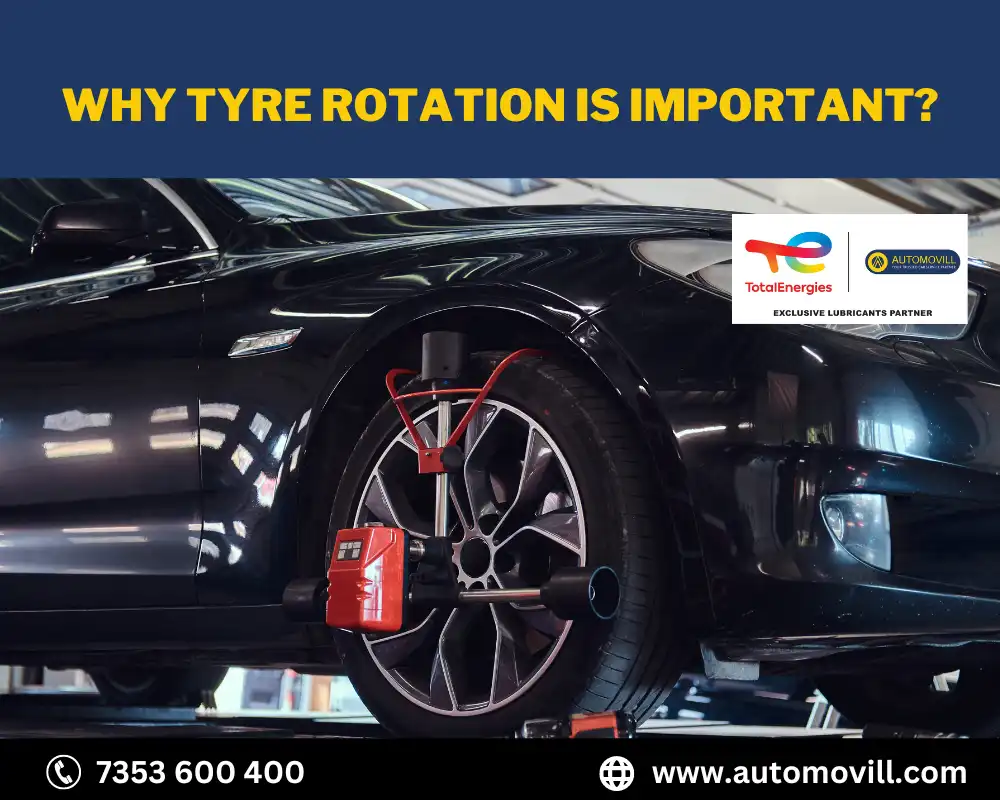
Tyre maintenance is crucial for ensuring the longevity and performance of your vehicle. Among various tire maintenance practices, tire rotation stands out as one of the most essential routines to keep your tires in optimal condition.
In this blog, we’ll explore the reasons why tyre rotation is important and how it benefits both your wallet and your safety on the road.
10 Reasons Why Tyre Rotation is Important?
Here we go:
1) Equalized Tyre Wear:
- Tires wear unevenly due to differences in weight distribution and driving conditions.
- Regular rotation helps distribute wear more evenly across all four tires.
- Even wear leads to a longer tire lifespan, saving you money on premature replacements.
2) Improved Traction and Performance
- Unevenly worn tyres can cause a decrease in traction and grip on the road.
- Rotating tires allows all four tires to share the workload evenly, enhancing overall performance.
- Better traction means improved handling and braking, especially in adverse weather conditions.
3) Enhanced Fuel Efficiency
- Unevenly worn tyres can lead to increased rolling resistance, reducing fuel efficiency.
- Tire rotation maintains proper tread depth, improving fuel economy and saving you money at the pump.
4) Balanced Ride and Comfort
- Unevenly worn tyres can cause vibrations and an uncomfortable ride.
- Rotation helps balance the tires, providing a smoother and more enjoyable driving experience.
5) Proper Wheel Alignment
- Proper tire alignment is essential for even tire wear and stable handling.
- Regular rotation can help identify alignment issues early on, preventing further damage to the tires and suspension components.
6) Maximized Performance of Tyre Warranty
- Many tire manufacturers offer warranties based on mileage.
- Regular rotation ensures you meet the warranty requirements and can claim replacements if necessary.
7) Safer Driving
- Unevenly worn tyres can lead to reduced traction and control, increasing the risk of accidents.
- Rotation helps maintain tire integrity, reducing the likelihood of blowouts and sudden tire failures.
8) Consistent Handling
- Regular tire rotation ensures all four tires have similar tread patterns and depths.
- Consistent handling contributes to better stability and predictability during cornering and lane changes.
9) Cost-Effective Maintenance
- Tire rotation is a simple and cost-effective maintenance procedure.
- It extends the life of your tires, postponing the need for new tire purchases.
10) A Well-Balanced Vehicle
- Vehicles tend to wear front or rear tires differently based on their drive type (front-wheel drive, rear-wheel drive, all-wheel drive).
- Rotation helps balance wear across all four tires, making your vehicle more balanced and predictable.
Tyre Rotation Patterns
1) Forward Cross
- Suitable for front-wheel drive vehicles.
- Move the front tires straight to the rear.
- Cross the rear tires to the front (left rear to right front, and right rear to left front).
- Ensures even wear distribution and maintains balanced traction.
2) X-Pattern
- Ideal for rear-wheel drive vehicles.
- Move the rear tires straight to the front.
- Cross the front tires to the rear (left front to right rear, and right front to left rear).
- Promotes even wear and maximizes performance for RWD cars.
3) Four-Wheel Drive (4WD) Pattern
- Suitable for all-wheel drive and 4WD vehicles.
- Cross the front tires to the opposite rear positions.
- Move the rear tires straight to the front.
4) Side-to-Side
- Primarily used for non-directional tires (tires with the same tread pattern on both sides).
- Move the front tires to the rear, on the same side.
- Move the rear tires straight to the front, on the same side.
Conclusion
Regular tyre rotation is an often-overlooked aspect of tire maintenance, but it plays a significant role in extending the life of your tires and ensuring your safety on the road.
By equally distributing tyre wear, enhancing performance, improving fuel efficiency, and promoting safer driving, tire rotation is a simple yet essential practice that should be a part of every vehicle owner’s maintenance routine.
Remember, a small investment of time and effort in tire rotation can lead to significant savings and a smoother driving experience in the long run.
So, don’t overlook this critical aspect of vehicle care and enjoy the many benefits it brings to your driving experience.
